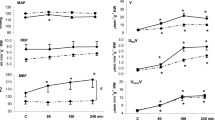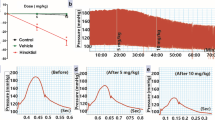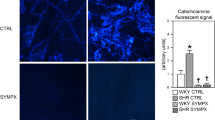Summary
Radiotracer techniques capable of measuring norepinephrine clearance and spillover rate into plasma were used to test the hypothesis that the antihypertensive effects of propranolol and atenolol in conscious spontaneously hypertensive rats are associated with an inhibition of norepinephrine release from postganglionic sympathetic neurons. The 10%–15% fall in mean arterial pressure produced over 4 h by propranolol (1, 3.3 and 10 mg/kg, s. c.) and atenolol (1, 3.3 and 10 mg/kg, s. c.) was not dose-related, and only the largest dose of propranolol caused a significant bradycardia. Each dose of atenolol significantly lowered heart rate. The decrease in blood pressure caused by propranolol and atenolol was not related to the decrease in heart rate. Both propranolol and atenolol inhibited norepinephrine clearance by 12% to 16%. The 1 mg/kg doses of propranolol and atenolol significantly suppressed norepinephrine spillover rate by 21 % and 32%, respectively, at 4 h postinjection. As the dose of propranolol was increased, the inhibition of norepinephrine spillover was reversed as plasma epinephrine concentration rose by 125%. The suppression of norepinephrine spillover rate caused by atenolol was more persistent but did diminish after the 10 mg/kg dose, when plasma epinephrine concentration was elevated by 55%. Both drugs suppressed plasma renin concentration, but the inhibition of norepinephrine spillover rate by propranolol and atenolol was not related to the fall in plasma renin concentration. By comparison, treatment with the adrenergic neuron blocking agent bretylium (5, 10, 20 and 40 mg/kg, s. c.) elicited a dose-related vasodepression with no change in heart rate or plasma renin concentration. The 10 mg/kg dose of bretylium inhibited norepinephrine spillover rate by 40%, but increasing the dose did not produce a further suppression of norepinephrine spillover rate. Bretylium caused a dose-related elevation of plasma epinephrine concentration (354% increase at 40 mg/kg). In a separate study, propranolol (10 mg/kg) and bretylium (40 mg/kg) significantly increased epinephrine spillover rate by 85% and 118%, respectively. Based on these data, we conclude that the β-adrenoceptor antagonists lower blood pressure by inhibiting norepinephrine release from postganglionic sympathetic neurons.
Similar content being viewed by others
References
Best JD, Halter JB (1985) Blood pressure and norepinephrine spillover during propranolol infusion in humans. Am J Physiol 248:R400-R406
Bolli P, Amann FW, Burkart F, Bühler FR (1982) Role of α-adrenoceptor-mediated vasoconstriction for antihypertensive β-blockade. J Cardiovasc Pharmacol 4:S162-S167
Borkowski KR (1988) Pre- and postjunctional β-adrenoceptors and hypertension. J Autonom Pharmacol 8:153–171
Bravo EL, Tarazi RC (1982) Plasma catecholamines in clinical investigation: a useful index or meaningless numbers? J Lab Clin Med 100:155–160
Buckingham RE, Hamilton TC (1980) Comparison of the antihypertensive response to β-adrenoceptor blocking drugs in intact and adrenal-demedullated spontaneously hypertensive rats. Br J Pharmacol 68:667–676
Daniell HB, Webb JG, Walle T, Oatis JE, Gaffney TE (1988) Inhibitors of prostaglandin synthesis reverse the effects of chronic β-receptor blockade to attenuate adrenergic neurovascular transmission in dogs. J Cardiovasc Pharmacol 12:300–307
Esler M, Jackman G, Leonard P, Skews H, Bobik A, Jennings G (1981) Effect of propranolol on noradrenaline kinetics in patients with essential hypertension. Br J Clin Pharmacol 12:375–380
Göthert M, Kollecker P (1986) Subendothelial β2-adrenoceptors in the rat vena cava: Facilitation of noradrenaline release via local stimulation of angiotensin II synthesis. Naunyn-Schmiedeberg's Arch Pharmacol 334:156–165
Hjemdahl P, Akerstedt T, Pollare T, Gillberg M (1983) Influence of β-adrenoceptor blockade by metoprolol and propranolol on plasma concentrations and effect of noradrenaline and adrenaline during i. v. infusion. Acta Physiol Scand 515 (Suppl):45–53
Jackson EK, Campbell WB (1981) A possible antihypertensive mechanism of propranolol: Antagonism of angiotensin II enhancement of sympathetic nerve transmission through prostaglandins. Hypertension 3:23–33
Kawasaki H, Cline WH Jr, Su C (1984) Involvement of the vascular renin-antiotensin system in beta adrenergic receptor-mediated facilitation of vascular neurotransmission in spontaneously hypertensive rats. J Pharmacol Exp Ther 231:23–32
Keeton TK, Biediger AM (1988) The measurement of norepinephrine clearance and spillover rate into plasma in conscious spontaneously hypertensive rats. Naunyn-Schmiedeberg's Arch Pharmacol 338:350–360
Keeton TK, Hall JS, Biediger AM (1987) Response of plasma norepinephrine concentration to the vasodepression caused by β-adrenoceptor antagonists in the conscious spontaneously hypertensive rat. J Cardiovasc Pharmacol 9:356–362
Kudo Y, Sokabe H (1982) The ratio of cardiac to vascular β-receptor blockade of atenolol and propranolol in spontaneously hypertensive rats in vivo. J Pharm Dyn 5:745–747
Majewski H, Rand MJ (1986) A possible role of epinephrine in the development of hypertension. Med Res Rev 6:467–486
Majewski H, Murphy TV (1989) Beta-adrenoceptor blockade and sympathetic neurotransmission in the pithed rat. J Hypertension 7:991–996
Majewski H, Hedler L, Schurr C, Starke K (1985) Dual effect of adrenaline on noradrenaline release in the pithed rabbit. J Cardiovasc Pharmacol 7:251–257
Man in't Veld AJ, Schalekamp MADH (1982) How intrinsic sympathomimetic activity modulates the haemodynamics responses to β-adrenoceptor antagonists. A clue to the nature of their antihypertensive mechanism. Br J Clin Pharmacol 13 [Suppl]:245S–257S
Man in't Veld AJ, Schalekamp MADH (1983) Effects of 10 different β-adrenoceptor antagonists on hemodynamics, plasma renin activity, and plasma norepinephrine in hypertension: The key role of vascular resistance changes in relation to partial agonist activity. J Cardiovasc Pharmacol 5 [Suppl]:S30-S45
Nakamura M, Jackson EK, Inagami T (1986) β-Adrenoceptor-mediated release of angiotensin II from mesenteric arteries. Am J Physiol 250:H144-H148
Pearson AA, Gaffney TE, Walle T, Privitera PJ (1989) A stereoselective central hypotensive action of atenolol. J Pharmacol Exp Ther 250:759–763
Pettersson K, Tuttle RS (1987) Immediate reduction of blood pressure and sympathetic nerve activity after β-blockade in anesthetized cats with deafferentiated arterial baroreceptors. Acta Physiol Scand 129:267–268
Peuler JD, Johnson GA (1977) Simultaneous single isotope radioenzymatic assay of plasma norepinephrine, epinephrine and dopamine. Life Sci 21:625–636
Poulson K, Jorgensen J (1974) An easy radioimmunological microassay of renin activity, concentration and substrate in human and animal plasma and tissues based on angiotensin I trapping by antibody. J Clin Endocrinol Metab 39:816–825
Privitera PJ, Granata AR, Underwood MD, Gaffney TE, Reis DJ (1988) C1 area of the rostral ventrolateral medulla as a site for the central hypotensive action of propranolol. J Pharmacol Exp Ther 246:529–533
Reid JL, Kopin IJ (1974) Significance of plasma dopamine β-hydroxylase activity as an index of sympathetic neuronal function. Proc Natl Acad Sci USA 71:4392–4394
Rosen SG, Supiano MA, Perry TJ, Linares OA, Hogikyan RV, Smith MJ, Halter JB (1990) β-Adrenergic blockade decreases norepinephrine release in humans. Am J Physiol 258:E999-D1005
Saelens DA, Daniell HB, Webb JG (1977) Studies on the interactions of propranolol with adrenergic neurons. J Pharmacol Exp Ther 202:635–645
Schmidt HHHW, Schurr C, Hedler L, Majewski H (1984) Local modulation of noradrenaline release in vivo: Presynaptic β2-adrenoceptors and endogenous adrenaline. J Cardiovasc Pharmacol 6:641–649
Schwartz DD, Eikenburg DC (1988) Enhanced endogenous neurotransmitter overflow in the isolated perfused rat kidney after chronic epinephrine administration: Lack of a prejunctional beta adrenoceptor influence. J Pharmacol Exp Ther 244:11–18
Struyker-Boudier HAJ, Smits JF, van Essen H (1979) The role of the baroreceptor reflex in the cardiovascular effects of propranolol in the conscious spontaneously hypertensive rat. Clin Sci 56:163–167
Tarizzo VI, Dahlöf C (1989) Adrenaline-induced enhancement of the blood pressure response to sympathetic nerve stimulation in adrenal demedullated pithed rats. Naunyn-Schmiedeberg's Arch Pharmacol 340:144–150
van den Meiracker AH, Man in't Veld AJ, van Eck HJR, Boomsma F, Schalekamp MADH (1988) Hemodynamic and hormonal adaptations to β-adrenoceptor blockade. A 24-hour study of acebutolol, atenolol, pindolol, and propranolol in hypertensive patients. Circ 78:957–968
van den Meiracker AH, Man in in't Veld AJ, Boomsma F, Blankestijn PJ, Schalekamp MADH (1990) Epinephrine-induced enhancement of sympathetic activity in humans: Inhibition by nonselective as well as β1-selective β-adrenoceptor blockade. J Cardiovasc Pharmacol 15:610–617
Veith RC, Best JD, Halter JB (1984) Dose-dependent suppression of norepinephrine appearance rate in plasma by clonidine in man. J Clin Endocrinol Metab 59:151–155
Westfall TC, Meldrum MJ (1985) Alterations in the release of norepinephrine at the vascular neuroeffector junction in hypertension. Ann Rev Pharmacol Toxicol 25:621–641
Author information
Authors and Affiliations
Additional information
Send offprint requests to T. K. Keeton at the above address
Rights and permissions
About this article
Cite this article
Kent Keeton, T., Biediger, A.M. Propranolol and atenolol inhibit norepinephrine spillover rate into plasma in conscious spontaneously hypertensive rats. Naunyn-Schmiedeberg's Arch Pharmacol 344, 47–55 (1991). https://doi.org/10.1007/BF00167382
Received:
Accepted:
Issue Date:
DOI: https://doi.org/10.1007/BF00167382




